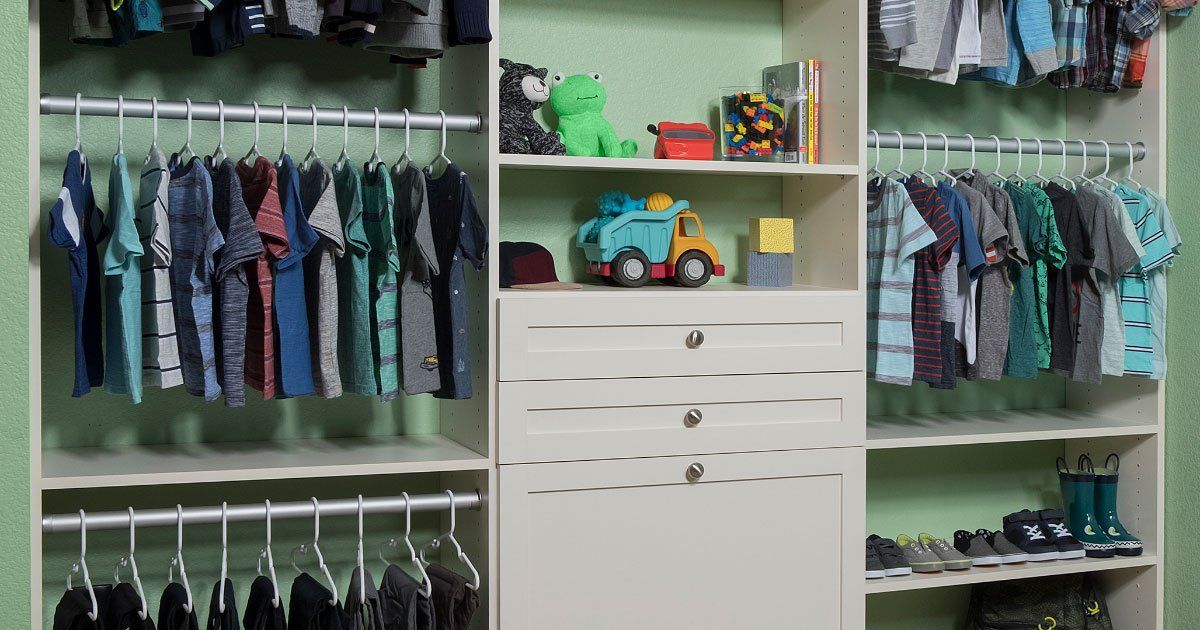
As parents, we all know the struggles of keeping our children's closets organized. From outgrown clothes to scattered toys, it can feel like a never-ending battle. However, reorganizing your child's custom closet should not be a stressful task. In fact, with a little planning and creativity, you can turn this seemingly daunting chore into a fun and rewarding project.
We will explore how to transform your child's closet space by decluttering and incorporating some playful design elements. Get ready to create a functional and whimsical haven that your child will love by following these simple steps.
- Declutter the closet
- Optimize storage solutions
- Incorporate fun and functional design elements
- Rotate toys and display favorites
- Label storage bins
- Customize storage for different ages and needs
- Teach and encourage organizational skills
1. Declutter the Closet
Before diving into the realm of design, it's essential to declutter your child's closet. The organizing experts at Connecticut Closets & Garages recommend taking everything out of the closet so that you have a blank slate to work with.
Start by going through each item, assessing its condition, and determining if it still fits your child or holds sentimental value. Be ruthless but thoughtful in your decision-making process. Remember, decluttering not only creates more space but also makes it easier for your child to find and maintain their belongings.
You can involve your child in this process, teaching them valuable lessons about organization and letting them have a say in what stays and what goes.
2. Optimize Storage Solutions
Once the clutter is out of the way, it's time to optimize your child's closet storage. Consider incorporating adjustable shelving units, hanging rods at varying heights, and baskets or bins for smaller items.
The closet pros at Better Homes & Gardens suggest choosing storage options that are hassle-free and easy for children to use. The less complicated means the more likely things will remain organized.
Use vertical space to maximize storage capacity, keeping frequently used items within easy reach. By customizing the closet to your child's needs, you'll make it simpler for them to maintain orderliness and encourage their independence.
3. Incorporate Fun and Functional Design Elements
Now comes the exciting part – adding playful design elements that will turn your child's closet into a magical space. Here are a few ideas to get you started:
a) Bright Colors and Themes: Use paint or removable wallpaper to create a vibrant backdrop. Consider your child's interests, whether it's a favorite cartoon character, a fairytale theme, or a sports motif. By incorporating their passions into the design, you'll make the closet a place they'll want to spend time in.
b) Chalkboard or Magnetic Surfaces: Transform a portion of the closet into a chalkboard or magnetic board. This allows your child to express their creativity, display artwork, and leave fun messages. It's an excellent way to personalize their space and make it truly their own.
c) Door Accessories: Decorate the closet doors with playful accessories like stickers, hooks, or even a growth chart. These additions not only add visual interest but also serve a practical purpose, providing additional storage options for bags, hats, or jewelry.
d) Lighting: Don't underestimate the power of good lighting. Install adequate lighting inside the closet to make it easier for your child to find what they need. Consider using motion-activated lights or LED strips to create a cozy and inviting atmosphere.
4. Rotate Toys and Display Favorites
To prevent your child's closet from becoming overwhelming, consider rotating their toys. Store some toys in a designated space outside the closet and periodically swap them out. This approach not only reduces clutter but also keeps the excitement alive as your child rediscovers their favorite playthings.
Additionally, create a display area within the closet to showcase their most cherished toys or stuffed animals. This adds a personal touch and keeps these items within easy reach when it's time to play.
5. Label Storage Bins
Incorporating labelling and organizational systems can work wonders in maintaining an organized closet. Use color-coded labels or picture labels for younger children to identify different categories of items.
Invest in clear plastic bins or transparent storage solutions to easily identify the contents of each container. This promotes a sense of order and makes it simpler for your child to put things back where they belong.
6. Customize Storage for Different Ages and Needs
As your child grows, their storage needs will evolve. Consider adjusting the closet setup to accommodate these changes. For infants and toddlers, incorporate lower shelving or cubbies for easy access to their clothes and toys.
As they get older, adjust the height of hanging rods and shelving to accommodate longer garments and larger toys. Adapting the closet to their age and needs ensures that it remains a functional and organized space throughout their childhood.
7. Teach and Encourage Organizational Skills
Transforming your child's closet is not just about creating an aesthetically pleasing space; it's also an opportunity to teach them valuable organizational skills. Take the time to show them how to fold clothes, categorize items, and maintain order.
Encourage them to participate in the tidying process and praise their efforts. By instilling these skills early on, you're equipping them with lifelong habits that will serve them well in the future.
Conclusion:
Reorganizing your child's custom closet doesn't have to be a stressful task. By following the steps outlined in this guide, you can transform their closet into a playful haven that reflects their interests and encourages organization.
From decluttering to incorporating fun design elements and optimizing storage solutions, each step contributes to creating a functional and creative space that your child will love. So, roll up your sleeves, get creative, and embark on this exciting journey of transforming your child's closet into their own little sanctuary.

